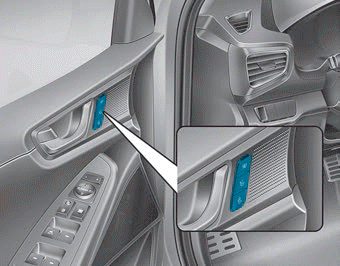Hyundai Ioniq: Rear Suspension System / Rear Upper Arm. Repair procedures
Hyundai Ioniq (AE) 2017-2025 Service Manual / Suspension System / Rear Suspension System / Rear Upper Arm. Repair procedures
| Removal |
| 1. | Loosen the wheel nuts slightly. Raise the vehicle, and make sure it is securely supported. |
| 2. | Remove the rear wheel and tire (A) from the rear hub.
|
| 3. | Loosen the rear upper arm mounting bolt and then remove the rear upper arm (A).
|
| 4. | Disconnect the rear wheel speed sensor connector (A).
|
| 5. | Remove the wheel speed sensor cable bracket.
|
| 6. | Remove the parking brake cable fromt the rear caliper. (Refer to Brake System - "Rear disc brake") |
| 7. | Loosen the wheel speed sensor cable bracket nut and then separate the cables from the trailing arm.
|
| 8. | Remove the parking brake cable bracket (A) and then separate the cables from the trailing arm.
|
| 9. | Remove the rear shock absorber (A) from the frame by loosening the bolt.
|
| 10. | Loosen the mounting bolt and then remove the trailing arm with the frame.
|
| 11. | Remove the main muffler. (Refer to Engine Mechanical System - Muffler") |
| 12. | After setting a jack, loosen the bolts and then remove the rear cross member.
|
| 13. | Loosen the bolt & nut then remove the rear upper arm with the sub frame.
|
| 14. | Install in the reverse order of removal. |
| Inspection |
| 1. | Check the bushing for wear and deterioration. |
| 2. | Check for all bolts and nut. |
 Rear Shock Absorber. Repair procedures
Rear Shock Absorber. Repair procedures
Removal1.Loosen the wheel nuts slightly.Raise the vehicle, and make sure it is securely supported.2.Remove the rear wheel and tire (A) from the rear hub...
 Rear Lower Arm. Repair procedures
Rear Lower Arm. Repair procedures
Removal1.Loosen the wheel nuts slightly.Raise the vehicle, and make sure it is securely supported.2.Remove the rear wheel and tire (A) from the rear hub...
Other information:
Hyundai Ioniq (AE) 2017-2025 Service Manual: Head Lamp Leveling Switch. Repair procedures
Inspection1.Disconnect the negative (-) battery terminal.2.Remove the crash pad lower panel (A).(Refer to Body - "Crash Pad Lower Panel")3.Disconnect the rheostat switch connector (A).4.Operate the BSD switch, then check for continuity between terminals of BSD switch connector...
Hyundai Ioniq (AE) 2017-2025 Service Manual: Condenser. Repair procedures
Inspection1.Check the condenser fins for clogging and damage. If clogged, clean them with water, and blow them with compressed air. If bent, gently bend them using a screwdriver or pliers.2.Check the condenser connections for leakage, and repair or replace it, if required...
Categories
- Manuals Home
- 1st Generation Ioniq Owners Manual
- 1st Generation Ioniq Service Manual
- Smart Cruise Control System
- Folding the side view mirrors
- Auto Door Lock/Unlock Features
- New on site
- Most important about car
Driver Position Memory System

The Driver Position Memory System is provided to store and recall the following memory settings with a simple button operation.
- Driver's seat position
- Side view mirror position
- Instrument panel illumination intensity
Copyright © 2025 www.hioniqae.com











